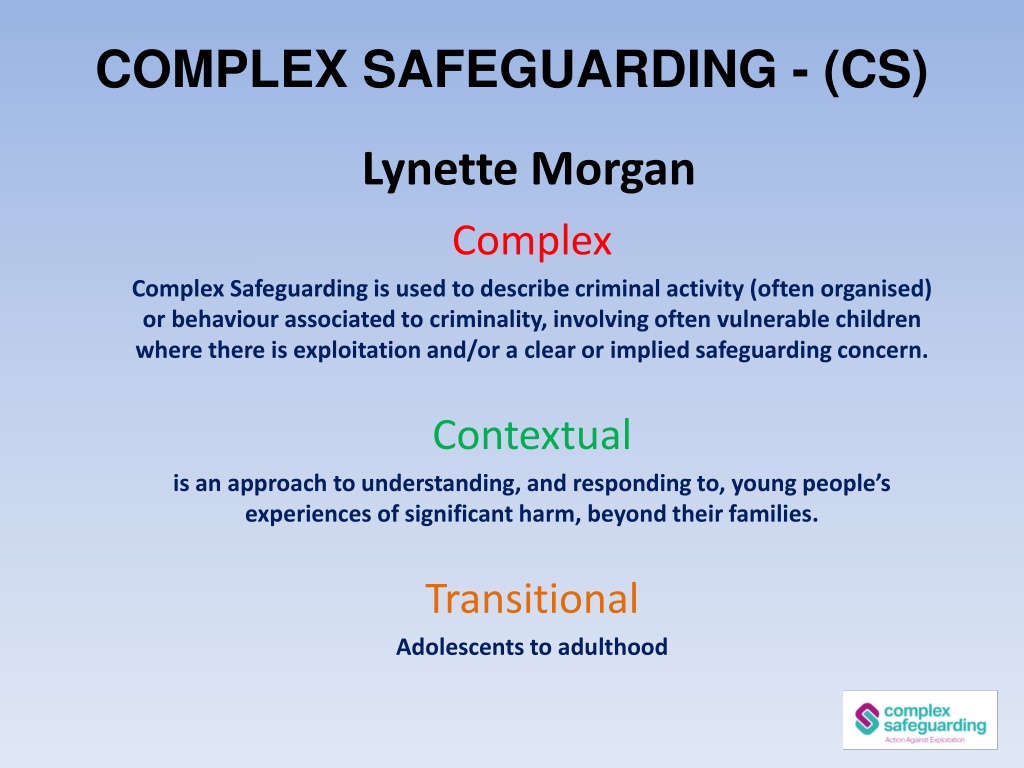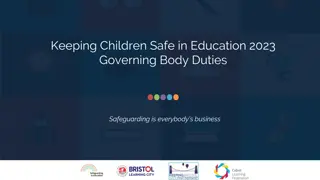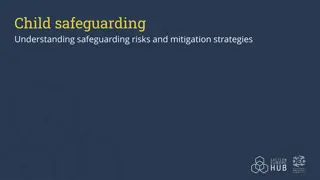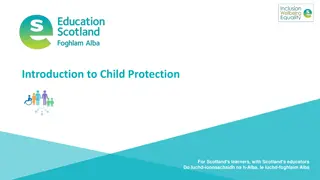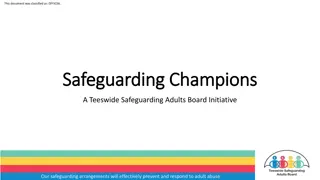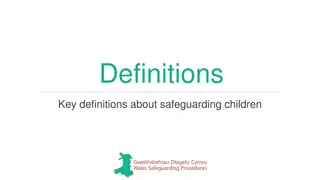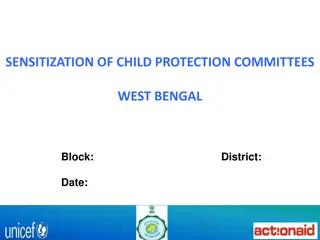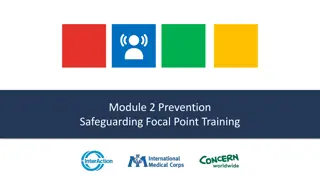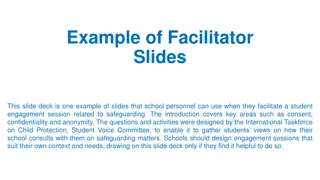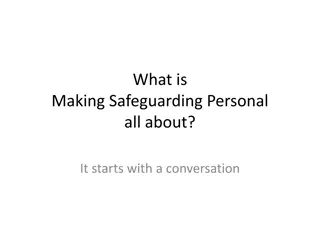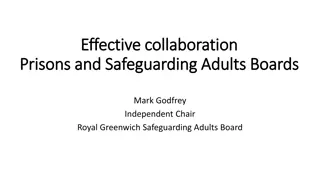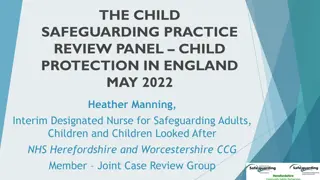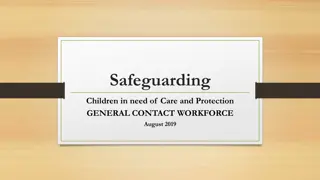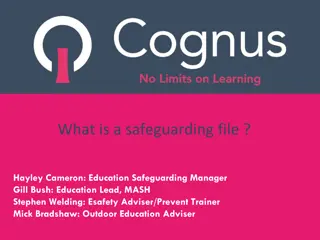Understanding Complex Safeguarding in Child Protection
Complex Safeguarding involves addressing criminal activities linked to vulnerable children and exploitation. The Child Sexual Exploitation Team focuses on building relationships with youth to reduce risks. The team, comprising various professionals, handles cases related to child sexual exploitation, criminal exploitation, modern-day slavery, and more, aiming at prevention, disruption, and convictions through direct work and multi-agency collaborations.
Download Presentation

Please find below an Image/Link to download the presentation.
The content on the website is provided AS IS for your information and personal use only. It may not be sold, licensed, or shared on other websites without obtaining consent from the author. Download presentation by click this link. If you encounter any issues during the download, it is possible that the publisher has removed the file from their server.
E N D
Presentation Transcript
COMPLEX SAFEGUARDING - (CS) Lynette Morgan Complex Complex Safeguarding is used to describe criminal activity (often organised) or behaviour associated to criminality, involving often vulnerable children where there is exploitation and/or a clear or implied safeguarding concern. Contextual is an approach to understanding, and responding to, young people s experiences of significant harm, beyond their families. Transitional Adolescents to adulthood
THE CHILD SEXUAL EXPLOITATION TEAM (CSE) The OFSTED inspection identified good CSE process in situ and the work had clearly developed during monitoring visits to the full inspection completed in May 2019. A number of audits were undertaken and cases subject to scrutiny during this time. In July 2019 a Peer review was undertaken this has identified a number of strengths while informing recommendations for planning and development. The CSE social worker focus is on relationship building with young people and this supports risk reduction. This was evidenced in the OFSTED Report: Direct work with children, supporting a child-centred and relationship-based approach to practice, is strongest in teams with specific functions, such as the child sexual exploitation (Page 4 Para 9.) This is the foundation for moving forward with Complex Safeguarding.
THE COMPLEX SAFEGUARDING - (CS) TEAM Social Care Team Manager 3 Full Time Social Workers 2 Family Intervention Worker (1 is a Parent worker) 1 Business Support Education Support Health Young People s Counselling Service Missing Service (Virtual) Psychological support to staff Police Detective Inspector 3 Detective Sergeants, 1 dedicated to each discipline. Challenger, CSE, CCE. Challenger 7 DC/PC s CSE 5DC s, 1PC. CCE- 3DC s 1 Operational Support Officer , 1 Investigative Assistant.
WHAT THE TEAM DOES THE REMIT CSE (Child Sexual Exploitation) CCE (Child Criminal Exploitation) MDS (Modern day Slavery) Organised Criminality Firearms Intelligence Threats to Life Investigations Daily Governance Direct Work with Children Work with Parents Raising Awareness Prevention Disruption Arrest and Conviction
How We Work Weekly multi-agency governance meetings are held The team s social care staff complete direct work with young people and their parents/carers, to support their understanding and reduce the risks associated with exploitation Our recently recruited Parenting Support Worker works with the parents and carers of the young people who are open to the team Young people are supported with ongoing police investigations and attending appointments with other agencies Regular reviews of each young person s level of risk determine whether the intervention is supporting the reduction of risk We have regular liaison with other partner agencies, which includes undertaking JET (Joint Enforcement Team) visits We have regular interaction with the NHS Safeguarding Team and the Off The Record Counselling Service Schools Officers support the CST by completing educational and preventative work with young people, to support their understanding and knowledge of exploitation
What is actually going on Many rural or out of town areas, such as Blackpool, have a short supply of drugs this is usually class A drugs such as cocaine, crack or heroin The rural areas are usually economically deprived and have a drug issue, so there is more demand Out of area city (Manchester) drug dealers have taken advantage of this The drug dealer will travel to Blackpool, using violence or threats to force smaller dealers out One number is set up for all drug users to call to buy drugs this is the Line The drugs are transported from Manchester to Blackpool daily The line bases itself in Manchester, customers contact it to order drugs, the dealer contacts a worker in Blackpool and gives orders of what to supply and where to meet the customer. As it is outside the rural area, this is now the County Line The worker is usually a child, who is being criminally exploited Drug supply is illegal, and will be investigated by the police; however, the CCE Team are involved in this point of the County Lines process
Disruption tactics A complex safeguarding investigation can take some time to complete. In that time, there is a concern that children may be at risk. Disruption tactics can be used to decrease the risks to children Working with partner agencies to share concerns for the particular child, so measures can be put in place to safeguard the child-one place this is done in Tameside is the monthly MACE panels Police have Protection Orders, which means they can detain a child if they are at risk Officers can enter an address they believe a child is in if they are at risk Child Abduction Warning Notices before there is enough evidence to suggest that an offence has been committed, police officers can consider issuing warning notices to potential offenders where grooming or exploitation is suspected Abduction of a child by other persons (under the age of 16) offence Recovery orders where a child has been unlawfully taken, or kept away from a person with lawful control of the child, a court can make a recovery order which requires the production of the child to the authorised officer. This authorises the child to be removed by the authorised officer. The order also requires anyone with information about the whereabouts of the child to disclose the information to the police. Arrest for human trafficking or any form of child exploitation NRM (National Referral Mechanism) referrals JET (Joint Enforcement Team) visits regular JET visits are undertaken with other agencies
Activity - Research in Practice Risk Taking Behaviours Before the age of 18 years old, Did you ever Privately make a note and add up the score Act Points Lie to someone about your age 5 Stay out later than you were supposed to 5 Lie to loved ones about something important 5 Drive a car or ride a motorbike without a licence 30 Steal from a shop 30 Smoke a cigarette before 16 15 Ignore the good advice of parents or carers 15 Watch 18 rated movies or look at 18 rated materials 10 Peer pressure a friend into doing something 10 Go to bars and clubs whilst underage 25 Get in cars with older friends or associates 25 Use drugs 30 Skip school 15 Get tattoo 30 Bully someone 20 Copy something dangerous that you saw someone else do 25 Had unprotected sex 30 Use alcohol 30 Steal from loved ones 10 Leave home or get kicked out 30 Hang out with someone you barely know 10 Go missing 20 Have sex before the age of 16 20 Significantly change your appearance or style 5 Hang around with people much older than you 20 Have a one night stand 30 Play in dangerous area s (train tracks, deep water etc.) 15 Physically assault someone (Hit, kick, Fight) 20 Tell parents and carers you were one place and went another 10 Have more than 5 sexual partners 30 Have a child 30
The results Score Result People 0-5 Safety Steve 0 5-20 Captain careful 0 20-100 School of hard Knocks graduate 1 105-200 Bonafide G award 3 205-300 Advanced swearing badge 9 305-400 Superior waste of space certificate 10 405-500 Diploma in Delinquency 10 505-600 Degree in real life 12 600+ Ultimate survivor 5 Average score 375 undertaken with a range of professionals (over 2000) including Retried police sergeant PHD youth studies Social worker Psychiatric nurse Cabin staff English teacher Student nurse Lecturer Dressmaker Residential support worker CEO PHD forensic psychology Administrator Mechanic Paediatric nurse Educational psychologist.
Act Model Achieving Change Together (ACT) is seen as a critical intervention. It is a strengths, relationship and evidence-based model for working with young people at risk of exploitation. The model is built around an ACT worker who adopts the ACT principles and takes the time to build a meaningful and trusting relationship with the young person. This worker takes the young person through the ACT pathway in order to help them identify their goals and together build a plan. ACT was developed in Rochdale and Wigan through a significant research phase that focused on what works and co-design with young people at risk of CSE.
Tameside, along with many GM areas, has determined the ACT model as the basis for working with children and their families where exploitation is a significant concern. The model was borne out of the out of borough costs for children being moved out of area in attempts to keep them safe. This interruption as opposed to intervention was costly and in essence removed children and young people for their families, peers, local communities and the very services that needed to support them. ACT practitioners are based within Complex Safeguarding Teams. ACT parent workers are key to the success of the model.
REFERRAL PATHWAY Proposed Complex Safeguarding (CS) Pathway Where Child Exploitation (CE), or the risk of it, is suspected, frontline practitioners should complete the online MARS and indicate within this the concerns for CE (Accessed via Safeguarding websites). MASH screen the information on receipt and record a threshold decision regarding the risk presented. MASH create the contact and progress to referral for social care assessment or other agency where appropriate for early help intervention. Where there are concerns for a group of children/young people this will be referred to CS team no later than 24 hours of receipt of contact (or sooner). Police will give consideration, where necessary, to holding a Silver meeting. Threshold not met for social care intervention. Threshold met for social care intervention. Progressed for assessment via S17 or S47 enquiry. Social Worker to complete CS referral (incorporating screening tool to determine risk). Early Help Assessment and Intervention.
REFERRAL PATHWAY.. continued . Social Worker to complete CS referral (incorporating screening tool to determine risk) LOW RISK Referral discussed at daily governance to determine allocation to CS Worker. CS worker completes Risk Measurement tool. All children considered to be medium or high risk from the referral will be risk assessed by the CS worker. Threshold for intervention not met. Case closed to CS Team. HIGH RISK MEDIUM RISK Section 47 Strategy Meeting - chaired by appropriate manager ensure CS manager is invited. Joint work C&F completed by SW. Phoenix Risk Assessment completed by Phoenix SW. LAC and Legal considered. CS Hazard on ICS put on by CS Team only. Joint work C&F Assessment completed by SW. Phoenix risk assessment completed by CS SW. Risk Measurement assessment at 3 months. CS Hazard on ICS put on by CS Team only. CS Manager will review all referrals and determine if the case should be brought to MACE panel. Risk measurement assessment review at 3 months. CS Manager will review all referrals and case should be brought to MACE panel.
MACE PANEL MACE considers each referral against intelligence held by the range of agencies represented at the meeting and intelligence provided by additional agencies unable to attend meetings. Ensuring MACE plan dovetails with the Safeguarding care plan for the child (CP/CIN/CFC). The child s welfare being paramount. MACE plan supplements safeguarding processes by contributing information. MACE Panel will have the opportunity to call upon the diverse skills and experience available amongst its members.
MACE Panel MACE panel which was established from August 2020 is to ensure multi- agency sharing of information to provide a coherent safeguarding response to individual children and the community. Provide the framework to allow regular information sharing and action planning to tackle child exploitation across Tameside. Following initial assessment by the CS worker the cause for concern and precipitating incident is discussed at the panel. Multi-agency plan to safeguard is developed, implemented and reviewed. MACE panel also ensures a strategic overview of up to date police operations, joint enforcement activity, awareness raising, disruption and education initiatives for the wider community. Any identified intelligence is shared not only internally but with wider partners in other authorities if deemed necessary. Themes, trends and hotspots are also identified and inform service delivery when needed.
Transitions Area of development Any young person aged 16 or above referred to adult services for consideration of service provision GM steering group underway undertaking research and utilising data to inform a GM model. Best practised being scrutinised from 10 GM area s to inform this. Adult Services undertaking review of their offer
